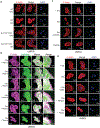Actin cytoskeleton vulnerability to disulfide stress mediates disulfidptosis
- PMID: 36747082
- PMCID: PMC10027392
- DOI: 10.1038/s41556-023-01091-2
Actin cytoskeleton vulnerability to disulfide stress mediates disulfidptosis
Abstract
SLC7A11-mediated cystine uptake suppresses ferroptosis yet promotes cell death under glucose starvation; the nature of the latter cell death remains unknown. Here we show that aberrant accumulation of intracellular disulfides in SLC7A11high cells under glucose starvation induces a previously uncharacterized form of cell death distinct from apoptosis and ferroptosis. We term this cell death disulfidptosis. Chemical proteomics and cell biological analyses showed that glucose starvation in SLC7A11high cells induces aberrant disulfide bonds in actin cytoskeleton proteins and F-actin collapse in a SLC7A11-dependent manner. CRISPR screens and functional studies revealed that inactivation of the WAVE regulatory complex (which promotes actin polymerization and lamellipodia formation) suppresses disulfidptosis, whereas constitutive activation of Rac promotes disulfidptosis. We further show that glucose transporter inhibitors induce disulfidptosis in SLC7A11high cancer cells and suppress SLC7A11high tumour growth. Our results reveal that the susceptibility of the actin cytoskeleton to disulfide stress mediates disulfidptosis and suggest a therapeutic strategy to target disulfidptosis in cancer treatment.
© 2023. The Author(s), under exclusive licence to Springer Nature Limited.
Figures
















Comment in
-
Deadly actin collapse by disulfidptosis.Nat Cell Biol. 2023 Mar;25(3):375-376. doi: 10.1038/s41556-023-01100-4. Nat Cell Biol. 2023. PMID: 36918690 No abstract available.
References
Methods-only references
Publication types
MeSH terms
Substances
Grants and funding
LinkOut - more resources
Full Text Sources
Medical
Research Materials
Miscellaneous

